Urticaceae
The Urticaceae /ɜːrtɪˈkeɪsiː/ are a family, the nettle family, of flowering plants. The family name comes from the genus Urtica. The Urticaceae include a number of well-known and useful plants, including nettles in the genus Urtica, ramie (Boehmeria nivea), māmaki (Pipturus albidus), and ajlai (Debregeasia saeneb).
| Nettle family | |
|---|---|
.jpg) | |
| Urtica dioica (stinging nettle) | |
| Scientific classification | |
| Kingdom: | Plantae |
| Clade: | Tracheophytes |
| Clade: | Angiosperms |
| Clade: | Eudicots |
| Clade: | Rosids |
| Order: | Rosales |
| Family: | Urticaceae Juss., 1789 |
| Synonyms | |
|
Cecropiaceae C. C. Berg[1] | |
The family includes about 2,625 species, grouped into 53 genera according to the database of the Royal Botanic Gardens, Kew and Christenhusz and Byng (2016).[2] The largest genera are Pilea (500 to 715 species), Elatostema (300 species), Urtica (80 species), and Cecropia (75 species). Cecropia contains many myrmecophytes.[3]
Urticaceae species can be found worldwide, apart from the polar regions.
Description
Urticaceae species can be shrubs (e.g. Pilea), lianas, herbs (e.g. Urtica, Parietaria), or, rarely, trees (Dendrocnide, Cecropia). Their leaves are usually entire and bear stipules. Urticating (stinging) hairs are often present. They have usually unisexual flowers and can be both monoecious or dioecious. They are wind-pollinated. Most disperse their pollen when the stamens are mature and their filaments straighten explosively, a peculiar and conspicuously specialised mechanism.
Taxonomy
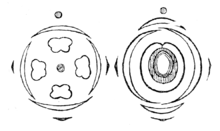
The APG II system puts the Urticaceae in the order Rosales, while older systems consider them part of the Urticales, along with Ulmaceae, Moraceae, and Cannabaceae. APG still considers "old" Urticales a monophyletic group, but does not recognise it as an order on its own.
Fossil record
The fossil record of Urticaceae is scattered and mostly based on dispersed fruits. Twelve species based on fossil achenes are known from the Late Cretaceous of Central Europe. Most were assigned to the extant genera Boehmeria (three species), Debregeasia (one species) and Pouzolzia (three species), while three species were assigned to the extinct genus Urticoidea.[4] A Colombian fossil flora of the Maastrichtian stage has yielded leaves that resemble leaves of the tribe Ceropieae.[5]
Phylogeny
Modern molecular phylogenetics suggest the following relationships[6][7] (see also [8][9][10][11][12][13][14][15][16][17]):
| |||||||||||||||||||||||||||||||||||||||||||||||||||||||||||||||||||||||||||||||||||||||||||||||||||||||||||||||||||||||||||||||||||||||||||||||||||||||||||||||||||||||||||||||||||||||||||||||||||||||||||||||||||||||||||||||||||||||||||||||||||||||||||||||||||||||||||||||
Tribes and genera
- Boehmerieae Gaudich. 1830
- Archiboehmeria C.J. Chen 1980 (1 sp.)
- Astrothalamus C.B. Rob. 1911 (1 sp.)
- Boehmeria Jacq. 1760 (80 spp.)
- Chamabainia Wight 1853 (1–2 spp.)
- Cypholophus Wedd. 1854 (15 spp.)
- Debregeasia Gaudich. 1844 (4 spp.)
- Gibbsia Rendle 1917 (2 spp.)
- Gonostegia Turcz. 1846 (5 spp.)
- Hemistylus Benth. 1843 (4 spp.)
- Neodistemon Babu & A. N. Henry 1970 (1 sp.)
- Neraudia Gaudich. 1830 (5 spp.)
- Nothocnide Blume 1856 (4 spp.)
- Oreocnide Miq. 1851 (15 spp.)
- Phenax Wedd. 1854 (12 spp.)
- Pipturus Wedd. 1854 (30 spp.)
- Pouzolzia Gaudich. 1826 [1830] (70 spp.)
- Rousselia Gaudich. 1826 [1830] (3 spp.)
- Sarcochlamys Gaudich. 1844 (1 sp.)
- Cecropieae Gaudich. 1830
- Cecropia Loefl. 1758 (70–80 spp.)
- Coussapoa Aubl. 1775 (>50 spp.)
- Leucosyke Zoll. & Moritzi 1845 (35 spp.)
- Maoutia Wedd. 1854 (15 spp.)
- Musanga R. Br. in Tuckey 1818 (2 spp.)
- Myrianthus P. Beauv. 1804 [1805] (7 spp.)
- Pourouma Aubl. 1775 (>50 spp.)
- Elatostemateae Gaudich. 1830
- Aboriella Bennet (1 sp.)
- Achudemia Blume 1856
- Elatostema J.R. Forst. & G. Forst. 1775 (300 spp.)
- Gyrotaenia Griseb. 1861 (4 spp.)
- Lecanthus Wedd. 1854 (1 sp.)
- Meniscogyne Gagnep. 1928 (2 spp.)
- Myriocarpa Benth. 1844 [1846] (18 spp.)
- Pellionia Gaudich. 1826 (60 spp.)
- Petelotiella Gagnep. in Lecomte 1929 (1 spp.)
- Pilea Lindl. 1821 (250 spp.)
- Procris Comm. ex Juss. 1789 (20 spp.)
- Sarcopilea Urb. 1912 (1 sp.)
- Forsskaoleeae Gaudich. 1830
- Australina Gaudich. 1830 (2 spp.)
- Didymodoxa E. Mey. ex Wedd. 1857 (2 spp.)
- Droguetia Gaudich. 1830 (7 spp.)
- Forsskaolea L. 1764 (6 spp.)
- Parietarieae Gaudich. 1830
- Gesnouinia Gaudich. 1830 (2 spp.)
- Parietaria L. 1753 (20 spp.)
- Soleirolia Gaudich. 1830 (1 sp.)
- Urticeae Lamarck & DC. 1806
- Dendrocnide Miq. 1851 (27 spp.)
- Discocnide Chew 1965 (1 sp.)
- Girardinia Gaudich. 1830 (2 spp.)
- Hesperocnide Torr. 1857 (2 spp.)
- Laportea Gaudich. 1826 [1830] (21 spp.)
- Nanocnide Blume 1856 (2 spp.)
- Obetia Gaudich. 1844 (7 spp.)
- Poikilospermum Zipp. ex Miq. 1864 (20 spp.)
- Touchardia Gaudich. 1847 (1–2 spp.)
- Urera Gaudich. 1826 [1830] (35 spp.)
- Urtica L. 1753—nettle (80 spp.)
- Zhengyia T. Deng, D.G. Zhang & H. Sun 2013 (1 sp.)[18]
- Incertae sedis
- Metatrophis F. Br. 1935 (1 sp.)
Diseases
The Urticaceae are subject to many bacterial, viral, fungal, and nematode parasitic diseases. Among them are:[19]
- Bacterial leaf spot, caused by Xanthomonas campestris which affects Pellionia, Pilea, and other genera
- Anthracnose, a fungal disease caused by Colletotrichum capsici which affects Pilea
- Myrothecium leaf spot, a fungal disease caused by Myrothecium roridum which affects plants throughout the Urticaceae, as well as other angiosperms[20][21]
- Phytophthora blight, a water mold disease caused by Phytophthora nicotianae which affects Pilea
- Southern blight, a fungal disease caused by Athelia rolfsii which affects both Pellionia and Pilea
Image gallery
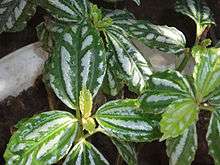 Pilea cadierei
Pilea cadierei- Pilea pumila
 Dendrocnide sp.
Dendrocnide sp.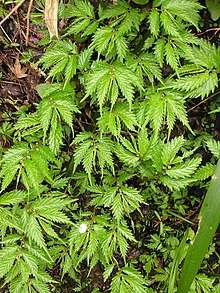 Elatostema umbellatum
Elatostema umbellatum- Urtica dioica
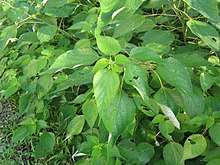 Boehmeria nivea
Boehmeria nivea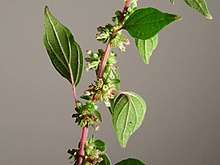 Parietaria judaica flowers
Parietaria judaica flowers Urtica dioica stinging hairs
Urtica dioica stinging hairs
References
- Germplasm Resources Information Network (GRIN) (2003-01-17). "Family: Urticaceae Juss., nom. cons". Taxonomy for Plants. USDA, ARS, National Genetic Resources Program, National Germplasm Resources Laboratory, Beltsville, Maryland. Retrieved 2008-04-24.
- Christenhusz, M. J. M., and Byng, J. W. (2016). "The number of known plants species in the world and its annual increase". Phytotaxa. 261 (3): 201–217. doi:10.11646/phytotaxa.261.3.1.CS1 maint: multiple names: authors list (link)
- Chomicki G, Renner SS. (2015). "Phylogenetics and molecular clocks reveal the repeated evolution of ant-plants after the late Miocene in Africa and the early Miocene in Australasia and the Neotropics". New Phytologist. 207 (2): 411–424. doi:10.1111/nph.13271. PMID 25616013.
- Early Flowers and Angiosperm Evolution by Else Marie Friis, Peter R. Crane, Kaj Raunsgaard Pedersen - Cambridge University Press, 18. aug. 2011 - ISBN 0521592836
- Phylogeny of the Cecropieae (Urticaceae) and the Evolution of an Ant-Plant Mutualism by Erin L. Treiber André Luiz Gaglioti Sergio Romaniuc-Neto Santiago Madriñán and George D. Weiblen - Published: February 11, 2016 - Systematic Botany 41(1):56-66. 2016 - https://doi.org/10.1600/036364416X690633
- Wu Z-Y, Monro AK, Milne RI, Wang H, Liu J, Li D-Z. (2013). "Molecular phylogeny of the nettle family (Urticaceae) inferred from multiple loci of three genomes and extensive generic sampling". Molecular Phylogenetics and Evolution. 69 (3): 814–827. doi:10.1016/j.ympev.2013.06.022. PMID 23850510.CS1 maint: multiple names: authors list (link)
- Wu Z-Y, Milne RI, Chen C-J, Liu J, Wang H, Li D-Z. (2015). "Ancestral state reconstruction reveals rampant homoplasy of diagnostic morphological characters in Urticaceae, conflicting with current classification schemes". PLoS ONE. 10 (11): e0141821. doi:10.1371/journal.pone.0141821. PMC 4631448. PMID 26529598.CS1 maint: multiple names: authors list (link)
- Sytsma KJ, Morawetz J, Pires JC, Morden CW. (2000). "Phylogeny of the Urticales based on three molecular data sets, with emphasis on relationships within Urticaceae". American Journal of Botany. 87 (6): 162.CS1 maint: multiple names: authors list (link)
- Sytsma KJ, Morawetz J, Pires C, Nepokroeff M, Conti E, Zjhra M, Hall JC, Chase MW. (2002). "Urticalean rosids: Circumscription, rosid ancestry, and phylogenetics based on rbcL, trnL–F, and ndhF sequences" (PDF). American Journal of Botany. 89 (9): 1531–1546. doi:10.3732/ajb.89.9.1531. PMID 21665755.CS1 maint: multiple names: authors list (link)
- Hadiah JT, Quinn CJ, Conn BJ. (2003). "Phylogeny of Elatostema (Urticaceae) using chloroplast DNA data". Telopea. 10 (1): 235–246. doi:10.7751/telopea20035618.CS1 maint: multiple names: authors list (link)
- Datwyler SL, Weiblen G. (2004). "On the origin of the fig: Phylogenetic relationships of Moraceae from ndhF sequences". American Journal of Botany. 91 (5): 767–777. doi:10.3732/ajb.91.5.767. PMID 21653431.
- Zerega NJC, Clement WL, Datwyler SL, Weiblen GD. (2005). "Biogeography and divergence times in the mulberry family (Moraceae)". Molecular Phylogenetics and Evolution. 37 (2): 402–416. CiteSeerX 10.1.1.418.1442. doi:10.1016/j.ympev.2005.07.004. PMID 16112884.CS1 maint: multiple names: authors list (link)
- Monro AK. (2006). "The revision of species-rich genera: A phylogenetic framework for the strategic revision of Pilea (Urticaceae) based on cpDNA, nrDNA, and morphology". American Journal of Botany. 93 (3): 426–441. doi:10.3732/ajb.93.3.426. PMID 21646202.
- Hadiah JT, Conn BJ, Quinn CJ (2008). "Infra-familial phylogeny of Urticaceae, using chloroplast sequence data". Australian Systematic Botany. 21 (5): 375–385. doi:10.1071/SB08041.CS1 maint: multiple names: authors list (link)
- Conn BJ, Hadiah JT (2009). "Nomenclature of tribes within the Urticaceae". Kew Bulletin. 64 (2): 349–352. doi:10.1007/s12225-009-9108-4. JSTOR 20649663.
- Kim C, Deng T, Chase M, Zhang D-G, Nie Z-L, Sun H. (2015). "Generic phylogeny and character evolution in Urticeae (Urticaceae) inferred from nuclear and plastid DNA regions". Taxon. 64 (1): 65–78. doi:10.12705/641.20.CS1 maint: multiple names: authors list (link)
- Treiber EL, Gaglioti EL, Romaniuc-Neto S, Madriñán S, Weiblen GD. (2016). "Phylogeny of the Cecropieae (Urticaceae) and the evolution of an ant–plant mutualism". Systematic Botany. 41 (1): 56–66. doi:10.1600/036364416X690633.CS1 maint: multiple names: authors list (link)
- Deng Tao, Kim C, Zhang D-G, Zhang J-W, Li Z-M, Nie Z-L, Sun H. (2013). "Zhengyia shennongensis: A new bulbiliferous genus and species of the nettle family (Urticaceae) from central China exhibiting parallel evolution of the bulbil trait". Taxon. 62 (1): 89–99. doi:10.1002/tax.621008. JSTOR 24389315.CS1 maint: uses authors parameter (link)
- "Common Names of Plant Diseases: Diseases of Foliage Plants (House Plants): Urticaceae". The American Phytopathological Society. 26 March 1993. Archived from the original on 30 November 2011.
- Chase, A. R. (1983). "Influence of host plant and isolate source on Myrothecium leaf spot of foliage plants" (PDF). Plant Disease. 67 (6): 668–671. doi:10.1094/PD-67-668.
- Nguyen, Thu Ha, Mathur, S. B., & Neergaard, Paul (1973). "Seed-borne species of Myrothecium and their pathogenic potential". Transactions of the British Mycological Society. 61 (2): 347–354, IN14–IN16. doi:10.1016/S0007-1536(73)80156-1.CS1 maint: multiple names: authors list (link)
Further reading
- Pignatti, Sandro (1982). Flora d'Italia (in Italian). Bologna: Edagricole. ISBN 978-88-506-2449-2.
- Friis, Ib (1989). Urticaceae. Flora of tropical East Africa. Rotterdam: A.A. Balkema and the Royal Botanic Gardens, Kew. ISBN 978-90-6191-352-8.
External links
| Wikimedia Commons has media related to Urticaceae. |
- Stevens, P. F. "Angiosperm Phylogeny Website, Version 13". Missouri Botanical Garden. continuously updated.